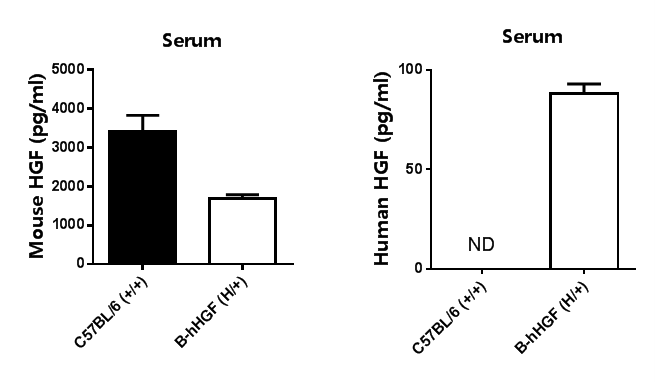B-hHGF mice
| Strain Name | C57BL/6-Hgftm1(HGF)/Bcgen | Common Name | B-hHGF mice |
| Background | C57BL/6 | Catalog number | 110868 |
|
Related Genes |
HGF(hepatocyte growth factor), DFNB39, F-TCF, HGFB, HPTA, SF | ||
Hepatocyte growth factor (HGF) or scatter factor (SF) is a paracrine cellular growth, motility and morphogenic factor. It is secreted by mesenchymal cells and targets and acts primarily upon epithelial cells and endothelial cells, but also acts on haemopoietic progenitor cells and T cells. It has been shown to have a major role in embryonic organ development, specifically in myogenesis, in adult organ regeneration, and in wound healing. It is secreted as a single inactive polypeptide and is cleaved by serine proteases into a 69-kDa alpha-chain and 34-kDa beta-chain. A disulfide bond between the alpha and beta chains produces the active, heterodimeric molecule. The protein belongs to the plasminogen subfamily of S1 peptidases but has no detectable protease activity. HGF has been implicated in a variety of cancers, including of the lungs, pancreas, thyroid, colon, and breast. Both overexpression of the Met/HGFR receptor protein and autocrine activation of Met/HGFR by simultaneous expression of the hepatocyte growth factor ligand have been implicated in oncogenesis. Hepatocyte growth factor interacts with the sulfated glycosaminoglycans heparan sulfate and dermatan sulfate. Hepatocyte growth factor regulates cell growth, cell motility, and morphogenesis by activating a tyrosine kinase signaling cascade after binding to the proto-oncogenic c-Met receptor.

Strain specific HGF expression analysis in heterozygous B-hHGF mice by ELISA.
Serum were collected from WT and heterozygous B-hHGF (H/+) mice, and analyzed by ELISA with species-specific HGF ELISA kit. Mouse HGF was detectable in WT and heterozygous B-hHGF mice. Human HGF was exclusively detectable in heterozygous B-hHGF but not WT mice.









